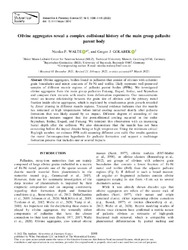Olivine aggregates reveal a complex collisional history of the main group pallasite parent body
DOI: https://doi.org/10.1111/maps.13810
Persistent URL: http://resolver.sub.uni-goettingen.de/purl?gldocs-11858/10064
Persistent URL: http://resolver.sub.uni-goettingen.de/purl?gldocs-11858/10064
Walte, Nicolas P.; Golabek, Gregor J., 2022: Olivine aggregates reveal a complex collisional history of the main group pallasite parent body. In: Meteoritics & Planetary Science, Band 57, 5: 1098 - 1115, DOI: 10.1111/maps.13810.
 |
Dokument öffnen: |
Olivine aggregates, bodies found in pallasites that consist of olivines with coherent grain boundaries and minor amounts of Fe‐Ni and troilite, likely represent well‐preserved samples of different mantle regions of pallasite parent bodies (PPBs). We investigated olivine aggregates from the main group pallasites Fukang, Esquel, Imilac, and Seymchan and compare their textures with results from deformation experiments. Our measurements reveal an inverse relationship between the grain size of olivines and the primary metal fraction inside olivine aggregates, which is explained by simultaneous grain growth retarded by Zener pinning in different mantle regions. Textural evidence indicates that the mantle has remained at high temperatures before initial cooling occurred shortly after pallasite formation that was likely caused by an impact. Different degrees of annealing of the deformation textures suggest that the postcollisional cooling occurred in the order Seymchan, Imilac, Esquel, and Fukang. We interpret this observation with an increasing burial depth after the collision. We also demonstrate that the mantle has not been convecting before the impact despite being at high temperature. Using the minimum critical Rayleigh number, we estimate PPB radii assuming different core radii. Our results question the recent ferromagmatism hypothesis for pallasite formation and support a multistage formation process that includes one or several impacts.
Statistik:
ZugriffsstatistikSammlung:
Schlagworte:
olivine aggregatesdunitic mantle material
pallasite formation
formation process
ferromagmatism hypothesis
This is an open access article under the terms of the Creative Commons Attribution‐NonCommercial License, which permits use, distribution and reproduction in any medium, provided the original work is properly cited and is not used for commercial purposes.

